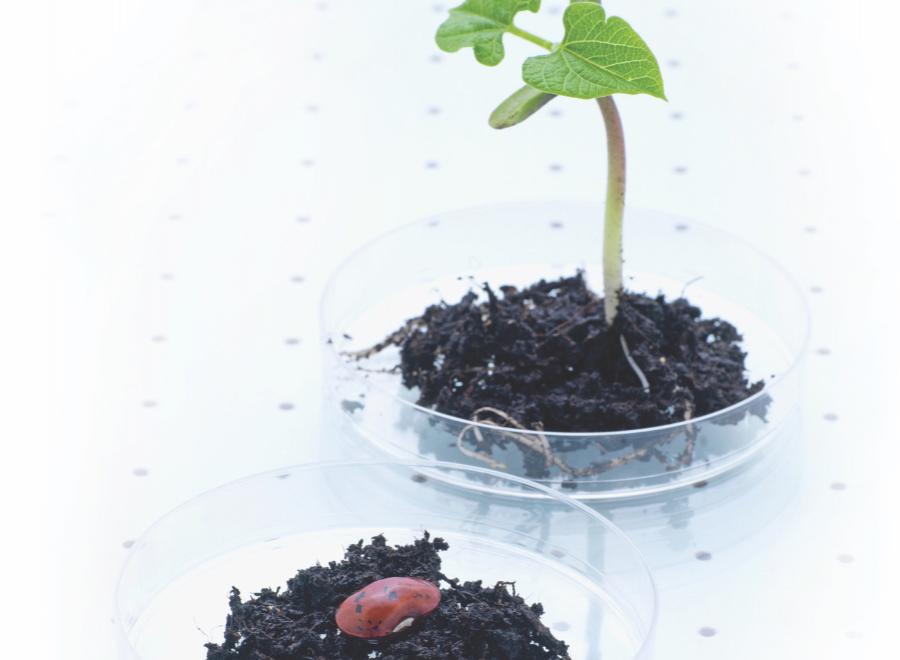“Good seed makes a good crop,” says the 16th-century proverb, an age-old, self-evident truth. But who owns the seed that makes the crop?
When I was a kid growing up in the Saskatchewan breadbasket, we all owned the seed. It was humanity’s birthright. And farmers kept their best seeds to plant for next year’s crops, gloating over the glossy kernels they stored in vast bins over the winter, awaiting spring furrows.
But these days, the answer to who owns the seed is not nearly so obvious. It’s rapidly shifting — and fraught with consequences. At stake is nothing less than billions of dollars in corporate profits and the health of billions of citizens.
The seemingly humble seed has wielded extraordinary power over human civilization since we began domesticating wild plants about 10,000 years ago, painstakingly coaxing them to make bigger or tastier fruit or ones that were less poisonous, notes the scientist Jared Diamond in his Pulitzer Prize-winning history Guns, Germs, and Steel: The Fates of Human Societies. Peas, he writes, were domesticated by Stone Age farmers around 8000 BC, but strawberries had to wait for the monks of the Middle Ages.
Agriculture led to respite from famine and starvation — at least sometimes. Communities could store farmed food in quantities impossible in a hunter-gatherer society. And that security led to population growth, leisure, the buildup of standing armies, intellectual enlargement and the concept of long-term planning, and eventually to reading and writing and the explosion of the arts and sciences. In other words, agriculture laid the groundwork for our modern civilization with its books, computers, cellphones, medical advances and seven billion citizens.
Today the seed, this foundation of civilization, is being recast as a unit of highly valuable, expensively researched, tightly controlled technology — something like a living computer chip — the first link in a massive global business relying on intellectual property, patents, licensing agreements and marketing. The International Seed Federation says that the global commercial seed market is worth US$45 billion, and the ETC Group, an international civil society organization based in Ottawa, calculates that slightly more than half of that market is controlled by just three companies: Monsanto, DuPont and Syngenta. In all, one in every five seeds planted anywhere in the world is owned by a corporation.
For big business, controlling the sale of seeds is the key to also controlling a complex food-production chain that includes not only the seeds and the pesticides and fungicides deemed necessary to grow them, but also the companies that process them into food. Three other companies – Nestlé, PepsiCo and Kraft – control nearly a fifth of the global processed-food market, which uses the crops. This means farmers are squeezed between behemoths at both ends of the food chain, in thrall to high costs for the seeds and low prices for the produce.
For some, this new seed market is a social advance. It means high-tech companies have the licence to develop genetically modified, proprietorial seeds that will help humanity by delivering greater amounts of healthier and safer foods. Patty Townsend, chief executive of the Canadian Seed Trade Association, which represents some of these corporations, said in an interview from Ottawa that the new biotech seeds are “really exciting tools” for the future that can lead to healthier oils and starches in crops and even remove allergens.
Ulrich Hoffmann agrees. The head of trade and sustainable development at the United Nations Conference on Trade and Development (UNCTAD), Hoffmann writes in a 2011 report that in a world altered by climate change, biotech seeds could greatly help us grow enough food for all. Citing a 2008 World Bank report, he notes that biotech seeds were responsible for as much as 50 percent of agricultural yield growth in the 1980s and 1990s, feeding as many as 15 million children who would otherwise have been malnourished and protecting millions of hectares of forest and other wilderness from cultivation, an environmental boon.
Yet the phenomenon of corporate-owned seeds is controversial. A 2006 UNCTAD analysis notes that the increasing corporate control over seeds represents “a move towards unprecedented convergence” among the three key segments of the agricultural market: the inventions themselves (developed by scientists who modify seeds’ genes to create specific traits, including resistance to pesticides), the seeds, and the chemicals used to grow them.
The UNCTAD secretariat calls this concentration of power, particularly on the biotechnology side, “very problematic” because it gives corporations “unprecedented power” and affects farmers’ age-old rights to save and replant the seeds they grow.
Why does it matter? For one thing, intensive industrial agriculture, where company-owned seeds are mainly used, requires two to three times more fertilizers and one-and-a-half times more pesticides to produce a kilogram of food than just 40 years ago, according to Hoffmann.
Modern agriculture also uses 10 times more energy than non-industrial agriculture and expends 10 calories of energy (in fuel, mainly) for every calorie of food produced. That’s economically possible because taxpayers heavily subsidize fossil fuels, he notes. It flips the whole, ancient idea of what agriculture is for — banking energy against future demand — on its head: “Agriculture has thus been turned from a historical net producer of energy to a net consumer,” Hoffmann writes.
Not only that, but this form of industrial agriculture has also drastically reduced the varieties of crops commonly grown, and without that variety, plants aren’t as resilient to climate change and dreadful weather.
What does this mean for the farmer in North America? If he or she wants to plant canola or corn or soy, for example, it’s uncommon to be able to buy seed not treated with a coating of neonicotinoid pesticide — which has been linked to massive bee die-offs and temporarily banned in Europe — often with added fungicides, sealed to the seed with plastic.
These expensive, proprietary chemicals grow with the expensive, proprietary seed, infusing each cell of each tissue of the plant: stalk, leaf, flower, nectar, pollen and seed head. Farmers must sign legally binding contracts that govern how the seeds can be used, and they have to buy the seeds anew every year. Many of them are hybrids, meaning they wouldn’t produce decent crops again even if the farmer tried saving and replanting.
It’s different from the time-honoured system in place when I walked the fields of Saskatchewan as a teenager. My relatives sowed seeds from the crops they grew, watching as some of the seeds adapted to the local environment, and collecting the ones that did the best for replanting in years to come. This was evolution in the wild, happening field by field. It’s still the mainstay in developing countries, where 80 to 90 percent of seeds for future crops are collected in this way, and it’s still the way wheat and several other crops are handled in Canada.
The corporate-seed system is also a departure from Canada’s long tradition of public investment in breeding new varieties of seeds for the good of all. This storied history of public seed breeding — conducted at government research stations or at universities — was a cornerstone of Canada’s strategy to settle the West in the 1880s and develop a robust agricultural economy.
It led to one of the most important seeds ever planted on the Canadian and eventually American Prairies: Marquis wheat. Developed in 1907, the wheat became a roaring success because it ripened three or four days earlier than other breeds and had shorter, plumper kernels. Its inventor, Charles Saunders, worked at the government’s Central Experimental Farm in Ottawa.
This plant-breeding work was a lucrative investment for the government, says a 2007 policy brief by the Canadian Agricultural Innovation Research Network (CAIRN). Intensive public support of plant breeding continued in Canada until about 40 years ago, when the trend toward more private investment began. Eventually, laws were established to allow intellectual property rights and patents over new plant varieties — typically held by companies, who can then sell the seeds to farmers at hefty profits.
To Pat Mooney, founder of the Ottawa civil society group ETC, this shift toward company-owned seeds concentrated in a few multinational corporate hands has happened remarkably quickly. When he first examined the global agriculture system about 40 years ago, there were roughly 7,000 seed companies in the public and private spheres, none of which had a significant market share, he said in an interview from Ottawa. Today, three companies control more than half of commercial seed sales, and 10 control about three-quarters of them. The public-sector involvement in seed breeding has collapsed, he said, and the companies that are now in control of global seed breeding are focused mainly on 12 major crops, including rice, soy, corn, canola, cotton and beans. Nearly half of all private-sector research is in a single crop — corn — because it is heavily used in all those processed foods.
Because the climate is changing so rapidly, farming conditions are also changing, Mooney noted. And that means, more than ever, crops need to be diverse, nimble and poised for adaptation, the opposite of the uniformity currently on offer by corporate-controlled monocultures. “We’ve made ourselves incredibly vulnerable,” he said.
In Canada today, the flashpoint in this complex story is Bill C-18, the Agricultural Growth Act, an omnibus bill aimed at, among other things, making sure that seed companies operating in Canada have as much legal protection over their inventions as those in most other countries. The bill has wide support among some farming organizations. Patty Townsend of the Canadian Seed Trade Association said it will give farmers access to varieties of seeds they can’t get now, an important benefit.
But Ann Slater, vice-president of policy for the National Farmers Union, said in an interview from her farm in St. Marys, Ont., that her organization opposes the bill on the grounds that it will concentrate the seed industry even further in the hands of big companies, possibly even encouraging them to take over the king of crops: wheat. The United Church of Canada has also publicly stated its concerns about the bill.
I was back in Saskatchewan this past summer, surrounded by fields of canola, tracking the work of a scientist who is looking at how pesticide-coated seeds are affecting this rich ecosystem. The prairie potholes dotting the fields are laced with pesticide residue throughout the year now. There’s mounting evidence that the chemicals are killing off even the good bugs, and this means some birds are going hungry. Other scientists are on a race to figure out whether the chemicals are affecting creatures that keep the soil healthy.
I had to wonder, standing there with the hot sun on my face and the wind rustling my hair, whether we’ve really thought this through. Whether we really want big corporations, certainly good at making profits, to be the ones making so many decisions about the future of the planet’s food and life-support systems. Wouldn’t it be sensible to have other voices in this discussion, too? Voices that had something to say about the long term, about food justice, about the common good?
***
This story first appeared in The United Church Observer’s October 2014 issue with the title “Seeds, Inc.”


Comments